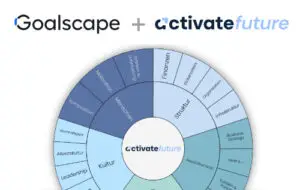I recently stumbled across a goal-setting process called OKR which stands for Objectives and Key Results. I wish I had done so earlier. OKRs are used on a daily basis by successful megaplayers like Intel, Google, LinkedIn and many others. The beauty lies in its simplicity and common sense. There is a lot to OKR but my key takeaways are:
- Set goals in short intervals. Maximum every quarter, minimum every month. Annual goals are too long-term: they do not reflect changing circumstances and priorities; and they are not specific enough to provide the day-to-day focus required, which means they can easily be usurped by daily operations and ‘firefighting’. Annual goals are like New Year’s resolutions. They fade and wither quickly and only result in a feeling of inadequacy. Quarterly goals foster a quicker success and learning cycle. They support focus, motivation and a result-oriented work ethic.
- Be ambitious with your Key Results. Aim high and try to find creative ways to achieve a goal that might seem unachievable at the beginning of the quarter (or month). According to John Doerr (who introduced OKR at Google in their early days), Googlers aim to consistently achieve 70% goal completion. My interpretation of this figure is that 70% should be well achievable within the context of skills, available resources and external limitations that are known at the time when the Key Results are defined. The remaining 30% can only be achieved through synergy and creativity – and this is exactly what this process fosters like no other approach. But you need to make sure to:
- Keep the performance evaluation process separate from the goal-setting process. The danger is that people will only commit to low goals to make sure they hit their targets and look like overachievers (this is called sandbagging). Base your performance evaluation on other criteria. Like how much someone helps others for example. For the CEO of The Lego Group, Jorgen Vig Knudstorp, helping has the highest priority. He says, blame is not for failure, it is for failing to help or ask for help. Get creative with your performance evaluation, but avoid sandbagging at any cost.
- Make Key Results as specific and measurable as possible. Objectives can be more general, but Key Results MUST be measurable and concrete. Not to measure performance, but to support a focussed work ethic.
- Don’t set too many goals. Agree on up to 6 high level goals for the year (these are the Objectives) and up to 4 Key Results for the quarter per team member. This also keeps efforts AND creative thinking focussed.
- Keep all Objectives and Key Results visible and transparent to anyone. An abstract and siloed documentation is inefficient because it does not support daily workflows and an open, constructive goal oriented culture.
Goalscape is a great tool to implement OKR on a personal, team or even enterprise level.
See our use-case blog: IT service provider ergovia relies on Goalscape for Management by OKR; and to use our OKR template, go to the Objectives and Key Results public goalscape, download it as a GSP file, then login to Goalscape and upload it using the ‘Import’ button in the Home screen.
And for an in-depth presentation on OKR, watch Google Ventures partner Rick Klau’s video here:



